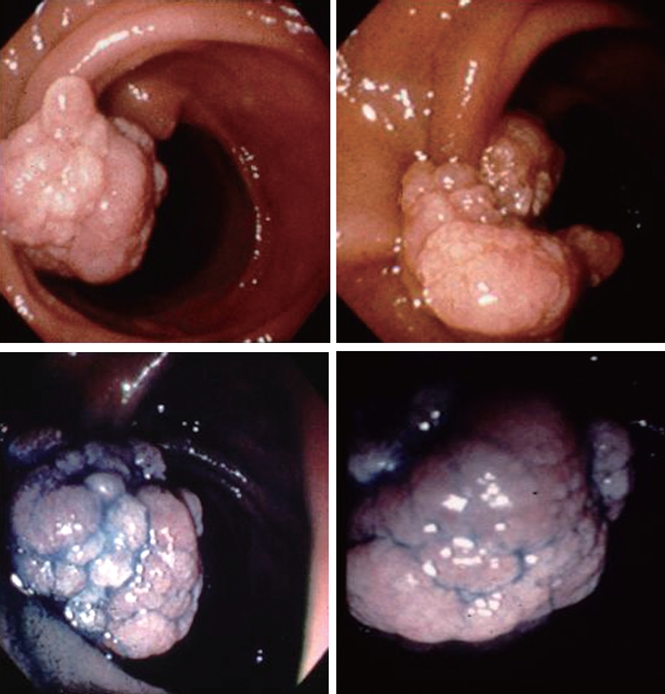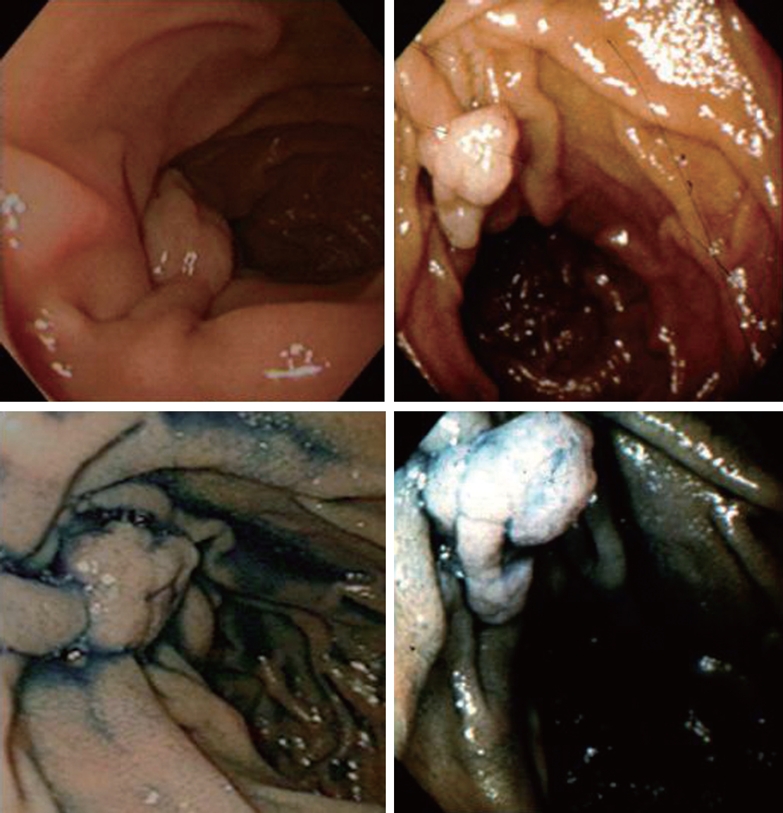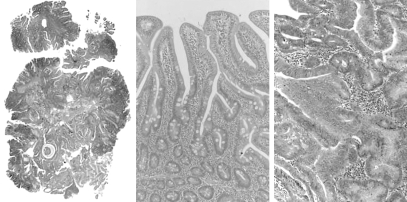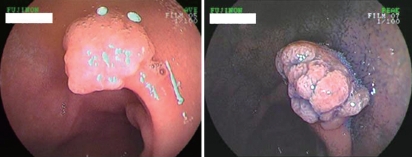Abstract
A solitary Peutz-Jeghers-type hamartomatous polyp in the duodenum is rare, and few reports have described its characteristic endoscopic features. We describe three cases of solitary Peutz-Jeghers-type hamartomatous polyp and their endoscopic findings in detail. The polyp in all of our three cases showed an irregularly lobular or nodular surface, whereas adenomas often show a regularly nodular or granular surface. The color of the polyp was whitish in all of our cases. In the present cases, close observation by endoscopy revealed that the solitary Peutz-Jeghers-type hamartomatous polyps looked whitish because of the presence of diffusely scattered white spots on the surface of the polyps. Duodenal polyps that exhibit the aforementioned endoscopic characteristics may be diagnosed as Peutz-Jeghers-type hamartomatous polyps and treated by polypectomy because of the malignant potential.
Keywords: Duodenal polyp, Hamartoma, Peutz-Jeghers polyp
INTRODUCTION
Peutz-Jeghers syndrome is a rare, autosomal-dominant disorder characterized by hamartomatous polyps in any part of the alimentary tract and mucocutaneous pigmentation[1]. Recently, a patient with a Peutz-Jeghers polyp without either mucocutaneous pigmentation or a positive family history was described as a case of solitary Peutz-Jeghers-type hamartomatous polyp. It has been suggested that this condition should be considered as a clinical entity different from Peutz-Jeghers syndrome[2]. A solitary Peutz-Jeghers-type hamartomatous polyp is histologically characterized by tree-like branching of smooth muscle fibers, with a core of smooth muscle, covered by mucosal tissue of near-normal appearance[3]. A solitary Peutz-Jeghers-type hamartomatous polyp in the duodenum is rare, and few reports have described its characteristic endoscopic features[2,4–10]. We describe three cases of solitary Peutz-Jeghers-type hamartomatous polyp and their endoscopic findings in detail. The polyp in patient 2 was unique in that a focus of adenocarcinoma was present within a solitary Peutz-Jeghers-type hamar-tomatous polyp.
CASE REPORT
Patient 1 was a 59-year-old woman. She visited our hospital complaining of epigastric discomfort. An upper gastrointestinal barium meal study revealed a polyp, 18 mm × 15 mm in diameter, in the second portion of the duodenum. Upper gastrointestinal endoscopy revealed a semi-pedunculated polyp on the oral side of the Papilla of Vater (Figure 1). Histological examination of a biopsy specimen obtained from the lesion showed hyperplastic duodenal mucosa, suggestive of the diagnosis of a hyperplastic polyp. Surgical resection of the polyp was performed under informed consent. Histologically, the polyp consisted of branching bundles of smooth muscle fibers covered by hyperplastic duodenal mucosa (Figure 2).
Figure 1.

Upper gastrointestinal endoscopy in patient 1 revealed a semi-pedunculated polyp, 18 mm × 15 mm in diameter, on the oral side of the Papilla of Vater. The polyp showed an irregularly lobular surface and slightly whitish color with diffusely scattered white spots on the surface.
Figure 2.

Histologically, the polyp consisted of branching bundles of smooth muscle fibers covered by hyperplastic duodenal mucosa.
Patient 2 was a 68-year-old woman. She visited our hospital because of epigastralgia. Upper gastrointestinal endoscopy revealed a peduncular polyp, 10 mm × 8 mm in diameter, in the second portion of the duodenum (Figure 3). Histological examination of a biopsy specimen obtained from the lesion revealed findings suggestive of an adenoma. Endoscopic polypectomy was performed. Histologically, the polyp consisted of branching bundles of smooth muscle fibers covered by hyperplastic duodenal mucosa containing a focus of cancer near the surface (Figure 4).
Figure 3.

Upper gastrointestinal endoscopy in patient 2 revealed a peduncular polyp, 10 mm × 8 mm in diameter, in the second portion of the duodenum. The polyp showed an irregularly lobular surface and slightly whitish color with diffusely scattered white spots on the surface.
Figure 4.
Histologically, the polyp consisted of branching bundles of smooth muscle fibers covered by hyperplastic duodenal mucosa containing a focus of cancer near the surface.
Patient 3 was a 60-year-old woman. Upper gastro-intestinal endoscopy as part of a health checkup revealed a semi-pedunculated polyp, 10 mm × 10 mm in diameter, in the duodenal bulb (Figure 5). Histological examination of a biopsy specimen obtained from the lesion showed hyperplastic duodenal mucosa. Endoscopic polypectomy was performed. Histologically, the polyp consisted of branching bundles of smooth muscle fibers covered by normal duodenal mucosa. Brunner’s glands existed in the central part of the polyp (Figure 6).
Figure 5.
Upper gastrointestinal endoscopy in patient 3 revealed a semi-pedunculated polyp, 10 mm × 10 mm in diameter, in the duodenal bulb. The polyp showed an irregularly nodular surface and slightly whitish color with diffusely scattered white spots on the surface.
Figure 6.
Histologically, the polyp consisted of branching bundles of smooth muscle fibers covered by normal duodenal mucosa. Brunner’s glands existed in the central part of the polyp.
All of the polyps showed an irregularly lobular or nodular surface and slightly whitish color with diffusely scattered white spots on the surface (Figures 1, 3 and 5). None of the three patients showed mucocutaneous pigmentation or a history of familial polyposis. We found no other polyps on colonoscopy or small-bowel follow-through examination with barium in any of the three patients.
DISCUSSION
A MEDLINE search of the English language literature revealed only nine well-documented cases of a solitary Peutz-Jeghers-type hamartomatous polyp of the duodenum (Table 1)[2,4–9]. Few of these reports have described the endoscopic characteristics of these polyps in detail. The polyp in each of our three cases showed an irregularly lobular or nodular surface, whereas adenomas often show a regularly nodular or granular surface; this finding was compatible with previous reports[2,5–9]. The color of the polyp was whitish in all of our cases, whereas previous reports have described the polyps to be red to normal color[6,7,9]. In the present cases, close observation by endoscopy revealed that the solitary Peutz-Jeghers- type hamartomatous polyps looked whitish because of the presence of diffusely scattered white spots on the surface of the polyps as Sugimoto et al reported[10]. We could not confirm the diagnosis by endoscopic biopsy in any of our cases because the polyps were covered by mucosal tissue of near-normal appearance. We consider that duodenal polyps that exhibit the aforementioned endoscopic characteristics may be diagnosed as Peutz-Jeghers-type hamartomatous polyps.
Table 1.
Endoscopic finding
| No | Author | Surface | Color | Biopsy | Therapy | Malignancy |
| 1 | Bott | Not described | Not described | Inflamation | Surgery | - |
| 2 | Naitoh | cerebriform | Not described | Not described | Endoscopic polypectomy | - |
| 3 | Tanaka | Lobrated | Not described | Not described | Endoscopic polypectomy | - |
| 4 | Tanaka | Multi lobrated | Reddish | Benign | Endoscopic polypectomy | - |
| 5 | Nerbi | Lobrated | Not described | Lymphoplastic | Surgery | - |
| 6 | Ichiyoshi | Lobrated or fine granular | Normal | Non neoplastic | Endoscopic polypectomy | - |
| 7 | Kitaoka | Lobrated | Not described | Not described | Endoscopic polypectomy | - |
| 8 | Itaba | Not described | Normal | Normal | Endoscopic polypectomy | - |
| 9 | Itaba | Lobrated | Normal | Normal | Endoscopic polypectomy | - |
| 10 | Our case1 | Lobrated or nodular | Whitish | Hyperplastic polyp | Surgery | - |
| 11 | Our case2 | Lobrated or nodular | Whitish | Adenoma | Endoscopic polypectomy | - |
| 12 | Our case3 | Lobrated or nodular | Whitish | Hyperplastic polyp | Endoscopic polypectomy | - |
The polyp in patient 2 was unique in that a focus of adenocarcinoma was present within the solitary Peutz-Jeghers-type hamartomatous polyp and histological examination of a biopsy specimen revealed findings suggestive of an adenoma. Hamartomatous polyps are generally considered to have very low malignant potential[11]. However, some reports described areas of neoplastic change, such as adenomatous or carcinomatous change in 3%-6% of the polyps in Peutz-Jeghers syndrome[12,13]. Ichiyoshi et al also reported a case of solitary Peutz-Jeghers-type hamartomatous polyp of the duodenum containing a focus of adenocarcinoma[7]. Therefore, because of the malignant potential, a solitary Peutz-Jeghers hamartomatous polyp of the duodenum should be removed.
In conclusion, a solitary Peutz-Jeghers-type hamar-tomatous polyp of the duodenum is endoscopically characterized by a lobular or nodular surface and whitish color with diffusely scattered white spots on the surface. Duodenal polyps that exhibit the aforementioned endoscopic characteristics may be diagnosed as Peutz-Jeghers-type hamartomatous polyps and treated by polypectomy because of the malignant potential.
Peer reviewer: Leonidas G Koniaris, Professor, Alan Livingstone Chair in Surgical Oncology, 3550 Sylvester Comprehensive Cancer Center (310T), 1475 NW 12th Ave, Miami, FL 33136, United States
S- Editor Zhu LH L- Editor Roberts SE E- Editor Liu Y
References
- 1.Jeghers H, McKusick VA, Katz KH. Generalized intestinal polyposis and melanin spots of the oral mucosa, lips and digits; a syndrome of diagnostic significance. N Engl J Med. 1949;241:1031–1036. doi: 10.1056/NEJM194912292412601. [DOI] [PubMed] [Google Scholar]
- 2.Acea Nebril B, Taboada Filgueira L, Parajo Calvo A, Gayoso Garcia R, Gomez Rodriguez D, Sanchez Gonzalez F, Sogo Manzano C. Solitary hamartomatous duodenal polyp; a different entity: report of a case and review of the literature. Surg Today. 1993;23:1074–1077. doi: 10.1007/BF00309096. [DOI] [PubMed] [Google Scholar]
- 3.Nakayama H, Fujii M, Kimura A, Kajihara H. A solitary Peutz-Jeghers-type hamartomatous polyp of the rectum: report of a case and review of the literature. Jpn J Clin Oncol. 1996;26:273–276. doi: 10.1093/oxfordjournals.jjco.a023227. [DOI] [PubMed] [Google Scholar]
- 4.Bott SJ, Hanks JB, Stone DD. Solitary hamartomatous polyp of the duodenum in the absence of familial polyposis. Am J Gastroenterol. 1986;81:993–994. [PubMed] [Google Scholar]
- 5.Naitoh H, Sumiyoshi Y, Kumashiro R, Inutsuka S, Fujita K, Yamamoto T, Murayama H. A solitary Peutz-Jeghers type hamartomatous polyp in the duodenum--a case report. Jpn J Surg. 1988;18:475–477. doi: 10.1007/BF02471476. [DOI] [PubMed] [Google Scholar]
- 6.Tanaka H, Iida M, Kohrogi N, Matsui T, Yasunami Y, Yao T, Nakamura K, Fujishma M. Endoscopic removal of solitary hamartomatous polyps of the duodenum. Gastrointest Endosc. 1990;36:640–642. doi: 10.1016/s0016-5107(90)71207-2. [DOI] [PubMed] [Google Scholar]
- 7.Ichiyoshi Y, Yao T, Nagasaki S, Sugimachi K. Solitary Peutz-Jeghers type polyp of the duodenum containing a focus of adenocarcinoma. Ital J Gastroenterol. 1996;28:95–97. [PubMed] [Google Scholar]
- 8.Kitaoka F, Shiogama T, Mizutani A, Tsurunaga Y, Fukui H, Higami Y, Shimokawa I, Taguchi T, Kanematsu T. A solitary Peutz-Jeghers-type hamartomatous polyp in the duodenum. A case report including results of mutation analysis. Digestion. 2004;69:79–82. doi: 10.1159/000077392. [DOI] [PubMed] [Google Scholar]
- 9.Itaba S, Namoto M, Somada S, Nakamura K, Kumashiro Y, Nakamura N, Yao T. Two cases of solitary Peutz-Jeghers-type hamartoma of the duodenum. Endoscopy. 2006;38 Suppl 2:E32–E33. doi: 10.1055/s-2006-944647. [DOI] [PubMed] [Google Scholar]
- 10.Sugimoto K, Shinohara Y, Katakami T, Abe K, Ueda K, Miyaoka M, Mochizuki M, Moriyasu F. A case of Peutz-Jeghers type polyp of the duodenum treated by endoscopic resection. Nippon Shokakibyo Gakkai Zasshi. 2005;102:1039–1044. [PubMed] [Google Scholar]
- 11.Bartholomew LG, Moore CE, Dahlin DC, Waugh JM. Intestinal polyposis associated with mucocutaneous pigmentation. Surg Gynecol Obstet. 1962;115:1–11. [PubMed] [Google Scholar]
- 12.Perzin KH, Bridge MF. Adenomatous and carcinomatous changes in hamartomatous polyps of the small intestine (Peutz-Jeghers syndrome): report of a case and review of the literature. Cancer. 1982;49:971–983. doi: 10.1002/1097-0142(19820301)49:5<971::aid-cncr2820490522>3.0.co;2-1. [DOI] [PubMed] [Google Scholar]
- 13.Narita T, Eto T, Ito T. Peutz-Jeghers syndrome with adenomas and adenocarcinomas in colonic polyps. Am J Surg Pathol. 1987;11:76–81. doi: 10.1097/00000478-198701000-00010. [DOI] [PubMed] [Google Scholar]





